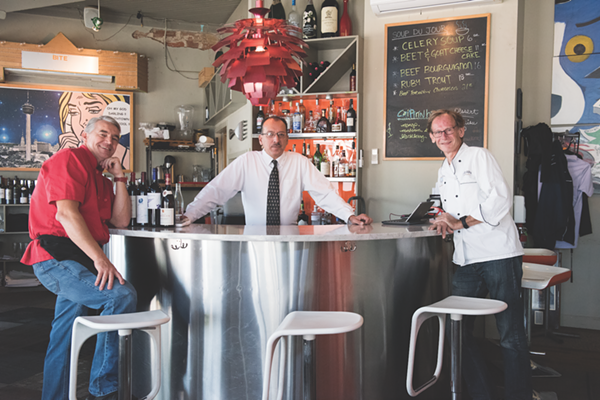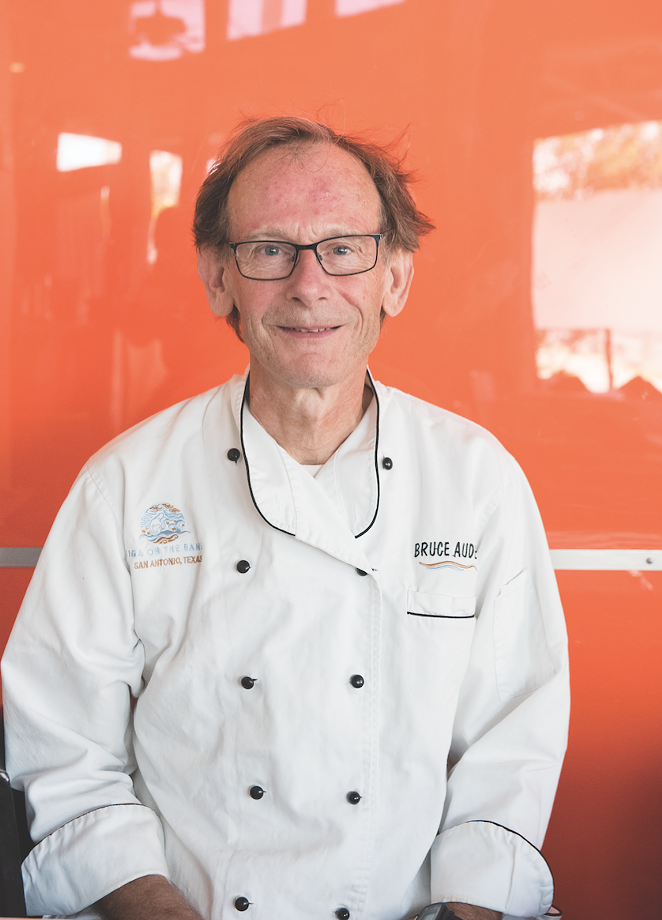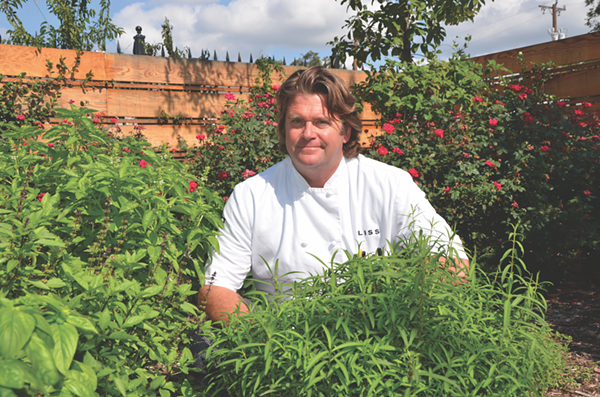Seasoned Chefs: Stayin' Alive in the Instagram Era
“Worst. Dinner. Ever.”
Words like this from “elite” Yelpers have goaded outspoken, globe-trotting chef Anthony Bourdain to reply in kind: “There’s really no worse, or lower human being than an elite Yelper,” he said.
Others have gleefully thrown Instagram under the same bus, lamenting its focus on how a plate looks rather than how it tastes. But even social media’s detractors would have to admit that there’s no denying its influence. Around the country, many established chefs have developed more nuanced approaches than Bourdain’s toward keeping up with my-way Millennials. For the record, here’s what three of SA’s restaurant pioneers think about stayin’ alive.
It was 1986 and the Fairmont Hotel, newly minted from an historic building that been moved six blocks from its original location, was celebrating its equally historic opening — complete with sensitive new additions and boasting of a posh restaurant called Polo’s. The debut chef of that operation, a lanky Brit out of London whose previous American experience included restaurants in Chicago, Dallas, and Houston, had been recruited to come up with a menu appropriate to the venue. “I was given carte blanche,” says Auden. The opening was announced in the old-fashioned way: newspaper articles based on press releases and phone calls by PR folks, TV interviews, word of actual, pre-Facebook mouth ... “Would you believe that there’s a wood-burning oven open to the dining room?”
Out of this oven (“We might have been a very different restaurant without it,” reflects Auden) and the kitchen behind it came food that transformed the culinary scene in San Antonio. “I was young and full of myself then, but luck was on my side,” says the chef, modestly. And though he freely admits that he wasn’t the only one in the country to be toying with a new Southwestern cuisine that admitted of influences from places as diverse as Asia and North Africa (Dean Fearing, Robert Del Grande, Mark Miller and Stephen Pyles came to mind), he was surely the first and only in San Antonio. Like-minded chefs kept up with one another not through Facebook, but at conferences and at charity events.
Auden left Polo’s at its peak in 1989, got married, and spent a couple of years working for others, notably Cappy Lawton, while putting together a place of his own. “I had no idea how to do that. I spent all my savings,” he admits.
But when Biga on Locust Street opened in 1991, it did so with both a bang and a bakery. Auden’s food might not have changed dramatically in the new location, but the bakery, made possible by wife Debra, was transformational; as Auden’s food had before, the bakery changed our relationship to a staple of life. It didn’t hurt, reflects Auden, that the bakery at the back of the old house that Biga occupied opened to the parking lot of the original location of Paesano’s, the immensely popular Italian restaurant run by Joe Cosniac, yet another pioneer of Alamo City eats. No Twitter publicity required here — just the aroma of fresh bread wafting from the ovens.
The Audens left the old house for shiny new digs downtown in 2000, a move that opened bigger doors to a new clientele — conventioneers and groups. Old-timers would still recognize the menu at Biga on the Banks, though the Southwestern aspect had given way to New American over the years. But marketing would inevitably change, largely at the hands of partner and Special Events Director Perny Shea.
Auden, who embraced the internet early in his restaurant career, says “I don’t like social media — but I have hired people who do it well.” As a result, the Biga website touts a BigAmigos membership group for special deals, lists ratings from the likes of Fodor and Trip Advisor, and provides links to Facebook, Twitter and YouTube. The boss may lament the fact that “people don’t like to sit down to a two-hour meal anymore,” but the Biga team is not about to let the Millennials get away altogether. That bar and other renovations are planned is not entirely due to the need for better Instagram light — but nobody denies that’s not a factor, either.
Another way Biga stays fresh in the face of demands from Millennials and Gen-Xers is to bring foxes back into the henhouse. More than any other restaurant in San Antonio, Auden’s kitchen has been an incubator of talent, with chefs such as Josh Cross, Tim Rattray and Jason Garcia among distinguished alumni. Luis Colon, formerly of Folc, is now back at Biga and “he’s doing Folc dishes, not Biga dishes .. and that’s great,” says Auden. But Biga’s most distinguished alum is doubtless Mark Bliss.
Bliss, now owner of his own, eponymous restaurant on South Presa, was with Auden from the start at the original Biga location. But even before that he got hired on at Polo’s — this after a still-short career that had begun with working at a sandwich shop at age 14, limo driving, playing in a rock band, managing an Italian trattoria, and getting hired as a prep cook at the Hilton Palacio del Rio, then still operating its classy steakhouse, Stetson. He became its chef after little more than two years.
Eager for a change and “hearing that the Fairmount was hiring, I walked down the street in a three-piece suit and applied,” he says. Having been told all positions had been filled, he got a “can you come in tonight?” call three days later. That was in 1986. “I loved it that there were tomatoes that tasted like tomatoes ... and that everybody who was anybody was there” in the dining room. “Bruce was a great mentor,” he says, and Bliss spent three years there as a “roundsman” able to do any position [in the kitchen] any day. “It was stressful but rewarding.” After three years, he responded to a call for a chef at a new French restaurant in The Collection on Broadway, adding that cuisine to his burgeoning resumé.
Bliss spent seven years, from 1991 to 1998, at Biga on Locust Street. “There was an ecstatic feeling of creativity — hard core, man. We were really invested in it.” But, inevitably, he wanted his own place. Also inevitably, he lacked the funds, so he helped Phil Dyer at then Farm to Market on Austin Highway open the first Silo, stepped away from that to do private catering and work on a movie set ... then came to back to Silo after it was purchased by Patrick Richardson. By 2010 he was ready for another break, so he and his wife moved back to his hometown in Northern California. “I thought about doing a Bliss-type concept there,” he says. But one day, stuck on a chair lift at Squaw Valley, he had a wild hair, placed a phone call to the owner of an abandoned service station on Presa, and Bliss was born. It opened on February 6, 2012.
These days, staff enthusiasm is key to keeping it fresh, says Bliss, “and I believe in promoting from within.” Tony Hernandez, the fresh and stylish-looking young guy now running the kitchen, has been at Bliss from “day one,” and he’s newly back from a restaurant tour of New York when we’re introduced. He’s also recently been checking out restaurants in Chicago and San Francisco. “Travel is great for inspiration,” says Hernandez. And if the Bliss menu hasn’t really changed that much from day one (the famous chicken-fried oysters are still there), the kitchen has instituted new dishes such as a nopal salad, is about to go deep with Texas-bred, Iberico-style cured ham, and has just turned out an impressive, new octopus appetizer for which Hernandez was responsible.
Sitting at the Bliss bar, however, it’s clear that the audience skews older. “We do get a younger crowd during Restaurant Week,” says Bliss — and some come back. But “I don’t use social media that much to promote,” he admits. Some of that is done for him, though, as Bliss was recently named No. 24 on Trip Advisor’s list of Best Fine-Dining Restaurants in the U.S. — in the company of such iconic places as New York’s Le Bernardin. All this while he works “four or five days a week in the most ‘blissful way’ possible.”
“I’ve become a restaurateur now, not a chef — goal achieved,” states Bliss. He’s free to spend more time playing his guitar; you Millennials can spend time at Bliss if you like. My words, not his.
Bliss got some friendly flack from Auden and another, albeit brief, Bigan when he got the Trip Adviser award. Now firmly established in San Antonio’s restaurant old guard, Damien Watel says he would hang out at the old Biga during a time he, too, was taking a break from cooking — as a vendor of used CDs. “I’d go to Biga at night. It was the only place I liked ... and I ended up in a [kind of] ‘will work for food’ situation in the kitchen.”
Watel grew up in northern France in a large family with an architect father who loved to cook and entertain. It seemed logical, then, that he would go to cooking school in Paris, after which he pursued the usual “practicum” route of being placed in various restaurants to learn the real ropes. About this time, he got a call from an uncle with restaurants in Dallas who said he was opening a new one. So, “little French boy goes to Dallas” in the early '80s to open Capriccio and get a taste of Italian cuisine. “Dallas cooking was what it was then,” says Watel — which is to say pedestrian. All the while, he was looking for the perfect location to open his own place.
Which he did in 1986 at the tender age of 26. “Nobody came the first day, and I freaked out. The next day two, then four…and finally I got a review in the [old media] Morning News.” About this time, he also started dating a girl from San Antonio, a relationship that eventually led to selling the Dallas place and moving here. “I was looking for a spot to do a bistro when some guys approached me to help open Café Soleil where Paloma Blanca is now. But it was a mess, a meat market, I was going home at 4 a.m. — not my thing ...” Bistro Vatel opened in 1999.
He didn’t stop there. More so than Auden and Bliss, Watel continued to hustle, opening (then closing) a pair of restaurants in Stone Oak, developing (then selling) La Frite in Southtown, tantalizing us with Ciao Lavanderia ... but through it all, though not without some ownership changes, the bistro remained the lodestone — until a recent dustup with the same landlord that Folc had a falling out with. Currently, Vatel is cooking at Bite, the diminutive Southtown restaurant opened by his media-savvy wife, Lisa Astorga Watel, while he contemplates his next move.
He’s found a spot on Broadway, and it will be the same as Bistro Vatel — except not. “There was a small market for French [when I arrived], and it’s literally dying off now. It’s a new ballgame, and I realize I’m a dinosaur.”
Watel’s push-back against extinction is to admit that “Millennials are truly a new generation — no way I can duplicate the old bistro. It needs to be slick, oh wow!” But it also needs to be more casual and inclusive, he says. “You can come in shorts, have an app at the bar ... maybe I’ll slip in some foie gras, but there might also be fried shrimp.” Still a French bistro, in other words, but aware of the food-truck mentality that characterizes both chefs and eaters alike in the Instagram Era. “Still creative at base, too…imagination needs to be there,” says Watel. Which is what will take Boomer chefs into the future — with or without active Facebook participation. – Ron Bechtol




